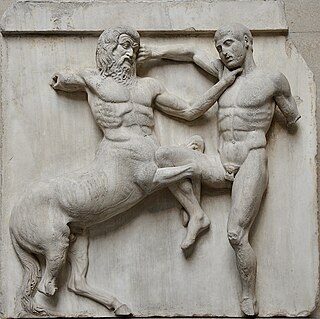
A centaur, occasionally hippocentaur, also called Ixionidae, is a creature from Greek mythology with the upper body of a human and the lower body and legs of a horse that was said to live in the mountains of Thessaly. In one version of the myth, the centaurs were named after Centaurus, and, through his brother Lapithes, were kin to the legendary tribe of the Lapiths.

A dragon is a magical legendary creature that appears in the folklore of multiple cultures worldwide. Beliefs about dragons vary considerably through regions, but dragons in Western cultures since the High Middle Ages have often been depicted as winged, horned, and capable of breathing fire. Dragons in eastern cultures are usually depicted as wingless, four-legged, serpentine creatures with above-average intelligence. Commonalities between dragons' traits are often a hybridization of feline, reptilian, mammalian, and avian features. Some scholars believe large extinct or migrating crocodiles bear the closest resemblance, especially when encountered in forested or swampy areas, and are most likely the template of modern Asian dragon imagery.

In ancient Greek religion, Hera is the goddess of marriage, women, and family, and the protector of women during childbirth. In Greek mythology, she is queen of the twelve Olympians and Mount Olympus, sister and wife of Zeus, and daughter of the Titans Cronus and Rhea. One of her defining characteristics in myth is her jealous and vengeful nature in dealing with any who offended her, especially Zeus's numerous adulterous lovers and illegitimate offspring.

Heracles, born Alcaeus or Alcides, was a divine hero in Greek mythology, the son of Zeus and Alcmene, and the foster son of Amphitryon. He was a descendant and half-brother of Perseus. He was the greatest of the Greek heroes, the ancestor of royal clans who claimed to be Heracleidae (Ἡρακλεῖδαι), and a champion of the Olympian order against chthonic monsters. In Rome and the modern West, he is known as Hercules, with whom the later Roman emperors, in particular Commodus and Maximian, often identified themselves. Details of his cult were adapted to Rome as well.

The Nemean lion was a monster in Greek mythology that lived at Nemea. Eventually, it was killed by Heracles (Hercules). Because its golden fur was impervious to attack, it could not be killed with mortals' weapons. Its claws were sharper than mortals' swords and could cut through any strong armour. In Bibliotheca, Photius wrote that the dragon Ladon, who guarded the golden apples, was his brother.

The Lapiths were a group of legendary people in Greek mythology, who lived in Thessaly in the valley of the Peneus and on the mountain Pelion. They were believed to have descended from the mythical Lapithes, brother of Centaurus, with the two heroes giving their names to the races of the Lapiths and the Centaurs respectively. The Lapiths are best known for their involvement in the Centauromachy, a mythical fight that broke out between them and the Centaurs during Pirithous and Hippodamia's wedding.

The Lernaean Hydra or Hydra of Lerna, more often known simply as the Hydra, is a serpentine lake monster in Greek mythology and Roman mythology. Its lair was the lake of Lerna in the Argolid, which was also the site of the myth of the Danaïdes. Lerna was reputed to be an entrance to the Underworld, and archaeology has established it as a sacred site older than Mycenaean Argos. In the canonical Hydra myth, the monster is killed by Heracles (Hercules) as the second of his Twelve Labors.

According to Greek mythology, the Chimera, Chimaera, or Chimæra was a monstrous fire-breathing hybrid creature from Lycia, Asia Minor, composed of different animal parts. It is usually depicted as a lion, with the head of a goat protruding from its back, occasionally depicted with dragon's wings, and a tail that might end with a snake's head. It was an offspring of Typhon and Echidna and a sibling of monsters like Cerberus and the Lernaean Hydra.

The Labours of Hercules or Labours of Heracles are a series of tasks carried out by Heracles, the greatest of the Greek heroes, whose name was later romanised as Hercules. They were accomplished in the service of King Eurystheus. The episodes were later connected by a continuous narrative.

Dragons play a significant role in Greek mythology. Though the Greek drakōn often differs from the modern Western conception of a dragon, it is both the etymological origin of the modern term and the source of many surviving Indo-European myths and legends about dragons.

Class of the Titans is a Canadian animated television series produced by Studio B Productions and Nelvana Limited. It premiered on December 31, 2005, at 5 pm ET/PT on Teletoon with a special 90-minute presentation of the first three episodes. The series aired in the United States on Qubo from September 19, 2009, to October 24, 2009. On April 1, 2012, the series returned to Qubo as part of its Qubo Night Owl block replacing "Spliced" where it remained until July 25, 2020.

The metopes of the Parthenon are the surviving set of what were originally 92 square carved plaques of Pentelic marble originally located above the columns of the Parthenon peristyle on the Acropolis of Athens. If they were made by several artists, the master builder was certainly Phidias. They were carved between 447 or 446 BC. or at the latest 438 BC, with 442 BC as the probable date of completion. Most of them are very damaged. Typically, they represent two characters per metope either in action or repose.
The Olympian Gods are characters based upon classical mythology who appear primarily in Wonder Woman, Captain Marvel and Aquaman comics.










